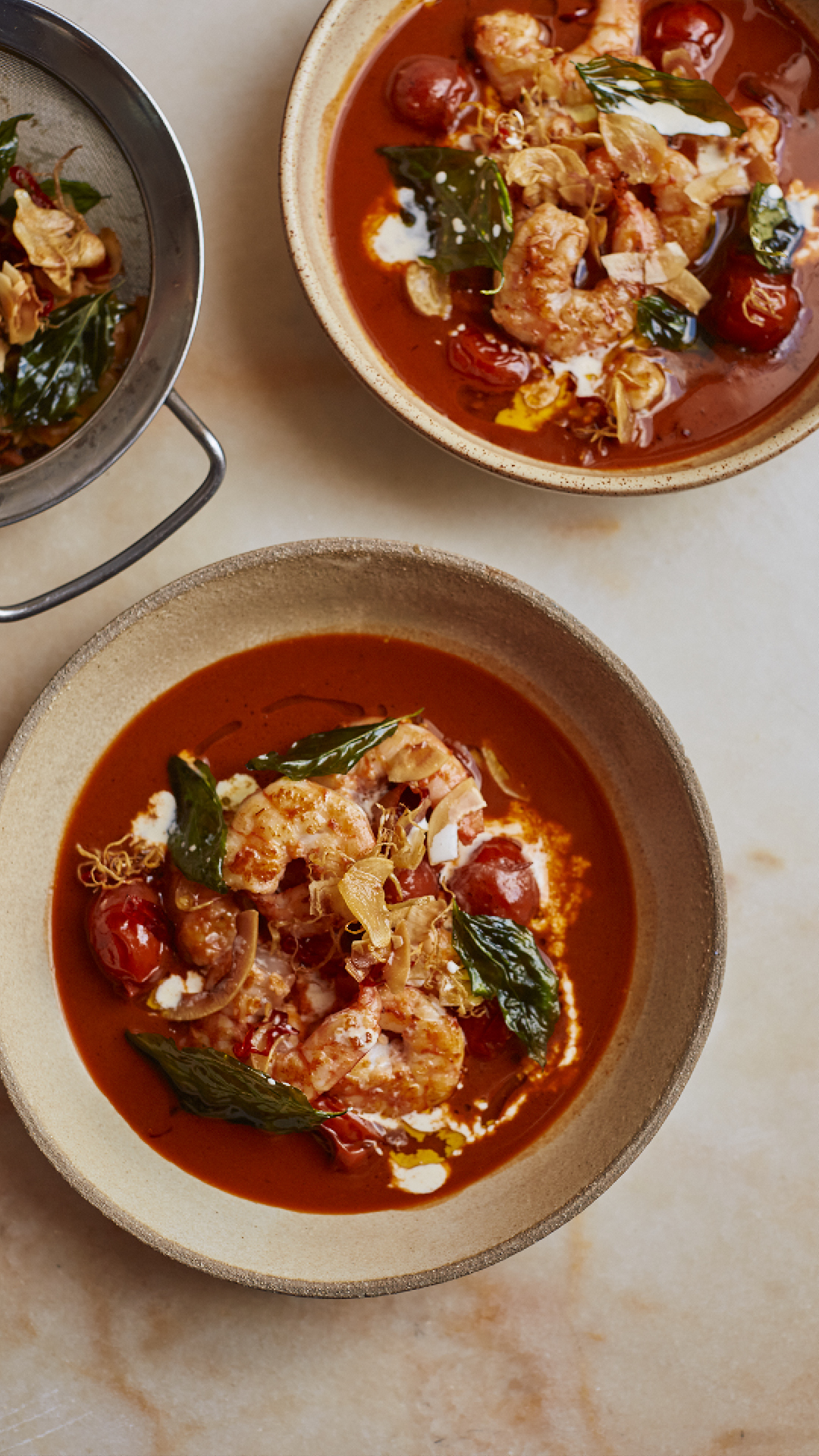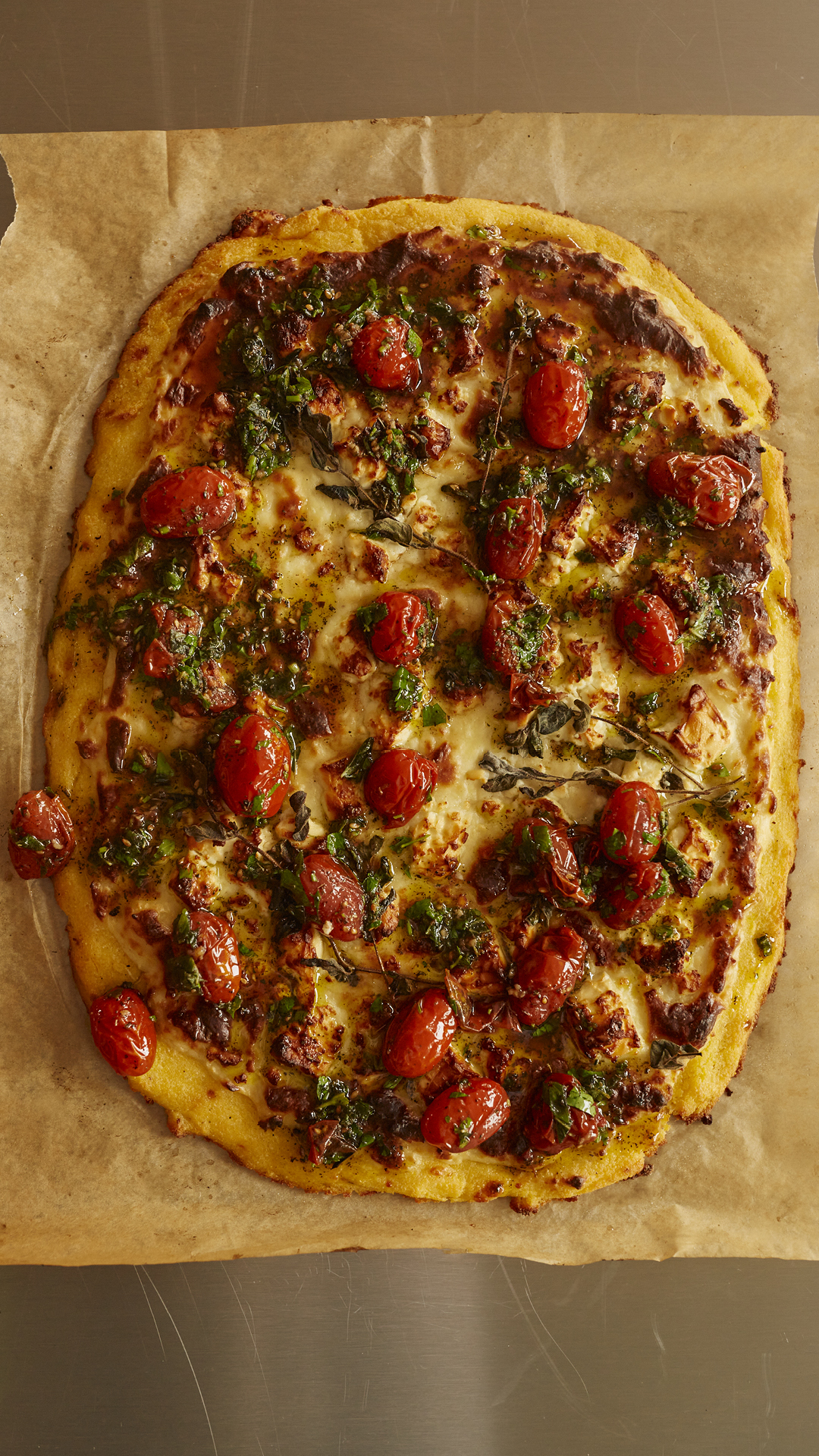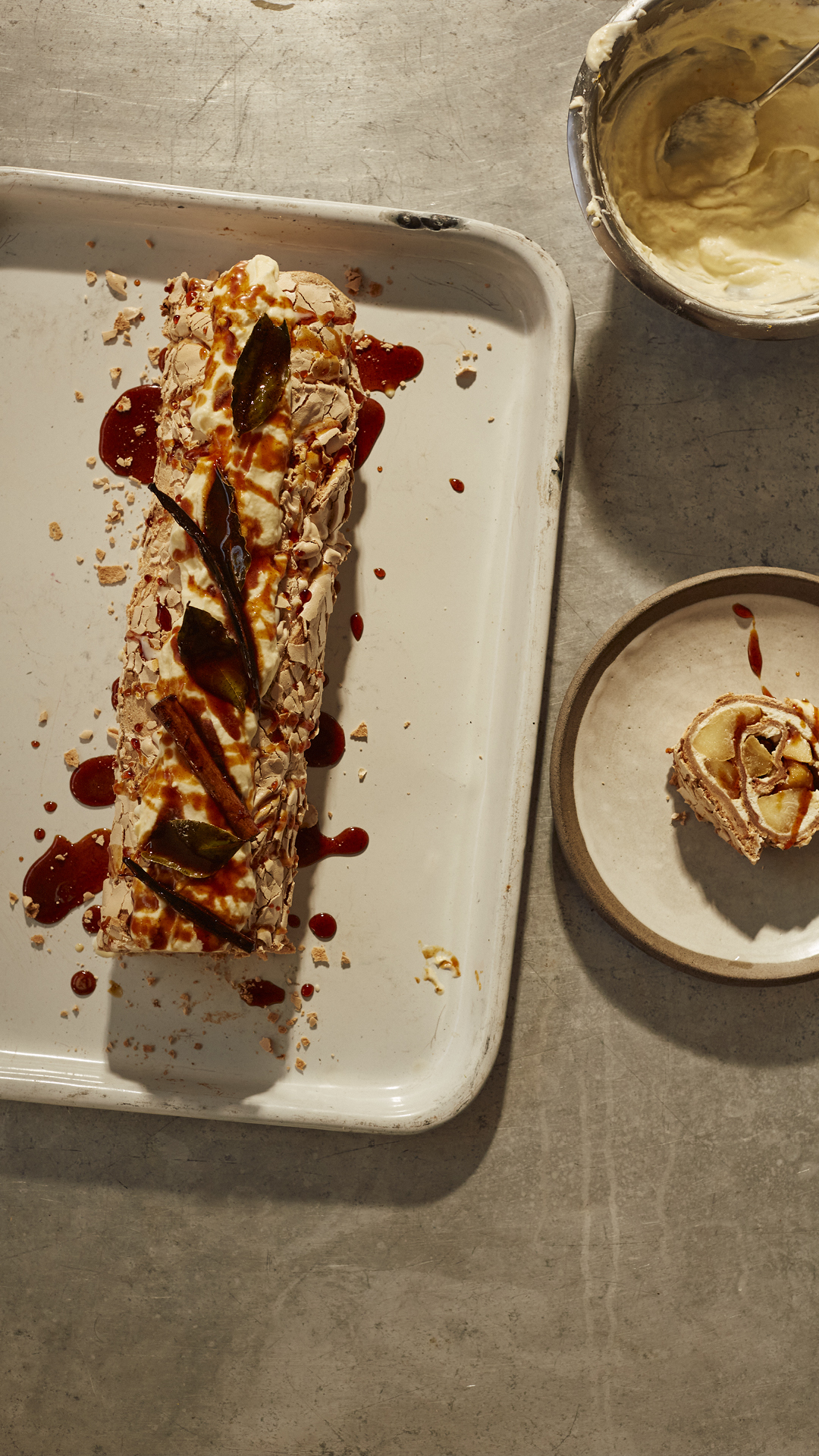
Flexible, flavour-packed dishes that all lend a little something 'extra' to your next meal. It's harissa butter on a roasted mushroom, then tossed with steamed veg or stuffed into a baked potato. It's tamarind dressing on turmeric fried eggs, then drizzled over a steak the next day. Rounded off with a chapter on the 'one basics' of desserts for you to perfect and then adapt with your favourite flavour combinations, such as a basic mousse transformed into coffee mousse with tahini fudge. This is cooking it forward, Ottolenghi style, filling your cupboards with adaptable homemade ingredients to add some oomph to every mealtime.
INDEX
Coconut Broth Prawns
with fried aromatics
“This dish is inspired by South East Asian flavours and is all about building depth starting with the base, which uses prawn shells to make a rich and spicy broth. Feel free to add other types of fish or shellfish, cooking them directly in the broth. Serve this with the fragrant coconut rice or just plain jasmine or brown rice.”
 Prep time: 25 minutes
Prep time: 25 minutes
Cook time: 45 minutes
Serves: 4
750g large tiger prawns, shells and heads on
2. tbsp olive oil
2 tbsp tomato paste
6 garlic cloves, peeled and bashed with the side of a knife
40g fresh ginger, peeled and thinly sliced
50g lemongrass stalks (about 4), roughly sliced
8 large makrut lime leaves
3 red chillies, roughly sliced, seeds and all (45g)
1 tin of full-fat coconut milk (400g)
60ml double cream, plus 2 tbsp extra to serve
250g datterini or cherry tomatoes
1 lime, cut into 4 wedges
salt
FRIED AROMATICS
105ml olive oil
6 garlic cloves, peeled and thinly sliced
2 red chillies, thinly sliced at a slight angle, seeds and all
30g fresh ginger, peeled and julienned
15g coconut flakes (aka coconut chips)
15g picked basil leaves
Peel the prawns – remove the heads and shells and set these aside. Devein the peeled prawns and refrigerate until needed.
Heat the oil in a large sauté pan, for which you have a lid, over a medium-high heat. Add the tomato paste and prawn heads and shells and cook, stirring occasionally, for 3 minutes or until deeply red. Add the garlic, ginger, lemongrass, lime leaves and chillies, and cook for a minute more, until fragrant. Add the coconut milk, cream, 450ml of water and 1 teaspoon of salt, bring to a simmer, then turn the heat down to medium-low, cover with the lid and leave to cook for 25 minutes. Strain through a sieve set over a large bowl, pressing down on the solids to extract as much flavour as possible (discard the solids, or save them for another use). Rinse out the sauté pan; you’ll use it again later.
Meanwhile, make the fried aromatics. Put the oil, garlic, chillies and ginger into a large frying pan over a medium heat. Cook for 8 minutes, stirring occasionally, then add the coconut flakes and a tiny pinch of salt and cook for 4 minutes more, or until the garlic and coconut are golden and the chillies transparent. Use a slotted spoon to transfer the solids to a plate lined with kitchen paper. Add the basil leaves to the frying pan and cook for 2–3 minutes more, or until deeply green and translucent. Drain them in a sieve set over a bowl, reserving the aromatic oil. Transfer the basil to the plate of fried aromatics. Wipe out the frying pan; you’ll use it for the prawns.
Add a tablespoon of the aromatic oil to the large sauté pan and place over a medium-high heat. Once hot, add the tomatoes and cook for 6–7 minutes, or until charred and starting to burst. Add the strained broth and bring to a simmer. Simmer for 3 minutes, then keep on a low heat while you fry the prawns.
Lastly, heat the large frying pan on a medium-high heat. Toss the prawns with ⅓ teaspoon of salt and 2½ tablespoons of the aromatic oil. Once the pan is very hot, fry the prawns for 60–90 seconds per side (flipping just to get them nice and coloured). If you’re overcrowding the pan, do this in two batches.
Divide the broth between four shallow bowls and top with the fried prawns. Squeeze a lime wedge over each of the bowls and drizzle each bowl with ½ tablespoon of the extra cream and a teaspoon of the aromatic oil. Top with the fried aromatics.
Fried aromatics
– Best fried on the day they’re served, use these to top rice dishes, roasted fish or even a creamy potato gratin.
Baked Polenta
with feta, bechamel and za’atar tomatoes
“It’s not a pizza, insisted Noor, when referring to this baked polenta, which does in fact look like a giant pizza. It ended up with multiple names at the Test Kitchen such as: ‘polenta-pizza’, ‘polizza’ or ‘polenta not-a-pizza’. It really is a happy-looking pie, with its yellows and reds and wonderfully golden edges. Serve with anything leafy and green. You can keep this gluten-free by swapping out the flour for gluten-free flour, if you like.”
 Prep time: 15 minutes
Prep time: 15 minutes
Cook time: 1 hour 30 minutes
Serves 4–6
80g unsalted butter
50g plain flour
750ml whole milk
4 garlic cloves, peeled and crushed
200g quick-cook polenta
65g pecorino romano, roughly grated
180g Greek feta, roughly crumbled
5g oregano sprigs (try to use the softer sprigs)
ZA’ATAR TOMATOES
400g datterini or cherry tomatoes
120ml olive oil
1. tbsp balsamic vinegar
2 garlic cloves, peeled and crushed
2 tbsp za’atar
½ tsp caster sugar
5g parsley, roughly chopped
5g oregano leaves, roughly chopped
salt and black pepper
Preheat the oven to 150°C fan.
Make the za'atar tomatoes. Put the tomatoes, oil, vinegar, garlic, ½ teaspoon of salt and a good grind of pepper into a medium baking dish, roughly 30cm x 20cm. Cover tightly with foil and bake for 40–45 minutes, stirring halfway through, or until the tomatoes have just burst but aren’t completely falling apart. Remove the foil, gently stir in the za’atar and sugar and leave to cool completely. Once cool, stir in the herbs (gently, so as not to break up the tomatoes).
Turn the heat up to 230°C fan. Line a large baking tray roughly 40cm x 30cm in size with baking parchment.
Put 40g of the butter into a medium saucepan over a medium-high heat. Once melted, add the flour and cook, whisking continuously, for 30 seconds or until it smells like popcorn. Slowly pour in 350ml of the milk, whisking continuously to avoid any lumps, then add the garlic, ½ teaspoon of salt and plenty of pepper, turn the heat down to medium and cook for 5 minutes, stirring often, until quite thick and no longer floury-tasting. Set aside and cover with a piece of baking parchment, to stop a skin forming.
Meanwhile, prepare the polenta by first putting the remaining 400ml of milk, 300ml of water, 20g of the butter, 1¼ teaspoons of salt and a good grind of pepper into a medium sauté pan (or saucepan) over a medium-high heat. Once it gently bubbles, turn the heat down to medium-low, slowly add the polenta, whisking continuously to incorporate, and cook for 2 minutes, to thicken. Add the pecorino and the remaining 20g of butter and stir with a spatula until incorporated. Quickly transfer to your prepared baking tray and spread out in a large oblong shape about 1cm thick and 38cm in length. Spoon over the bechamel and spread it so it covers the surface, leaving a 1 1/2 cm rim exposed around the edges. Top evenly with the feta and the oregano sprigs and bake for 22 minutes, or until golden and bubbling on top and starting to brown around the edges. Leave to cool for 5–10 minutes.
Spoon about half the za’atar tomatoes on top of the baked polenta, serving the rest in a bowl alongside. Use a pizza cutter to easily cut into slabs and serve warm.
Za’atar tomatoes
– Keep in a sealed container in the fridge for up to a week.
– Try spooning these on to bruschetta or using them as a sauce for pasta.
One Basic Meringue Roulade
Brown sugar meringue roulade with burnt honey apples
“If the flavours of autumn could be rolled into one, this meringue roulade would be the result: warming cinnamon, burnt honey, sweet apples and tangy orange come together to make a dessert fit for the festive season. Make sure all your individual components have completely cooled before assembling – you don’t want to create any excess moisture in the roulade. Get ahead by preparing the apples and cream the day before, keeping them refrigerated until needed.
 Prep time: 15 minutes
Prep time: 15 minutes
Cook time: 1 hour 30 minutes
Chilling time: 30 minutes to 3 hours
Serves 8
APPLES
150g runny honey
1 vanilla pod, halved lengthways, seeds scraped out and reserved with the pod
5 fresh bay leaves
1 cinnamon stick
½ tsp ground cinnamon
½ tsp flaked sea salt
3½ tbsp orange juice
1.1kg Braeburn apples (about 7–8), peeled, cored and each cut into 6 wedges (or 8 if they’re larger)
1 tbsp olive oil
ROULADE
250g egg whites (from 6 large eggs, or from an egg white carton)
100g light soft brown sugar
250g caster sugar
1 tbsp vanilla bean paste or vanilla extract
1. tsp ground cinnamon
2 tsp white wine vinegar
2 tsp cornflour
CREAM
150ml whipping cream, fridge cold
20g icing sugar
250g mascarpone, fridge cold
1 tbsp finely grated orange zest, plus 1 tsp extra to garnish
Preheat the oven to 200°C fan.
Start making the filling. Put the honey, vanilla seeds and pod, bay leaves, cinnamon stick, ground cinnamon and salt into a large ovenproof sauté pan on a medium-high heat. Bring to a simmer and cook for 5–6 minutes, stirring often, until the honey is deeply brown (don’t be afraid to take it to the edge; you want it to be very dark). Off the heat, whisk in the orange juice. Gently pour 65g of the burnt honey into a heatproof bowl. Pick out the bay leaves and vanilla pod and add them to the bowl.
Stir the apples and olive oil into the sauté pan with the remaining burnt honey, then transfer to the oven for 20 minutes, stirring halfway through, until the apples have softened and caramelised but still retain their shape. Set aside to cool completely. Pick out the cinnamon stick and add it to the reserved burnt honey bowl. Keep the oven on.
Make the roulade. Line a large 40cm x 30cm baking tray with baking parchment.
Put the egg whites into the bowl of a stand mixer with the whisk attachment in place and beat on medium-high speed for 1 minute, until soft peaks form. Combine both sugars in a bowl and gradually add this to the mixer, a tablespoon at a time, whisking continuously on high speed for 5 minutes, until the mixture is a thick glossy meringue. Reduce the speed to low and add the vanilla paste, cinnamon, vinegar and cornflour. Turn the speed to medium and whisk for a minute, to fully combine.
Spoon the meringue on to the prepared tray and use a spatula to spread it out evenly so it’s about 35cm x 25cm. Transfer to the oven and immediately turn the heat down to 180°C fan. Bake for 30–32 minutes, until the meringue is crusty on top and lightly brown. Set aside to deflate and cool completely.
Meanwhile, prepare the cream by putting the whipping cream, icing sugar and mascarpone into the cleaned bowl of the stand mixer with the whisk attachment in place. Beat on medium speed for 1–2 minutes, until soft peaks form. Stir in the orange zest.
Place a clean tea towel on top of the cooled meringue and quickly invert the whole thing on to a work surface. Lift the tin off and peel away the lining. Spread three-quarters of the cream evenly all over the meringue. Top evenly with the burnt honey apples (reserving any liquid released from the apples for another use).
Starting with the longest side closest to you and using the tea towel to assist you, roll the meringue up and over, so that the edges come together to form a log. Gently pull away the tea towel as you roll, then slide the meringue on to a long tray or platter, seam side down. Use a serrated knife to trim off 2cm from the sides to create neat edges (nibble on these if you like!). Refrigerate to firm up, at least 30 minutes (and up to 3 hours if you’re getting ahead).
To serve, spoon the remaining cream down the length of the roulade. Top artfully with the bay leaves, vanilla pod halves and cinnamon stick. Drizzle with the reserved burnt honey syrup and sprinkle with the extra zest.
Extracted from Ottolenghi Test Kitchen: Extra Good Things by Noor Murad and Yotam Ottolenghi (Ebury Press). All photography by Elena Heatherwick.
YOU MAY ALSO ENJOY
Recipe: Flavour by Yotam Ottolenghi & Ixta Belfrage









